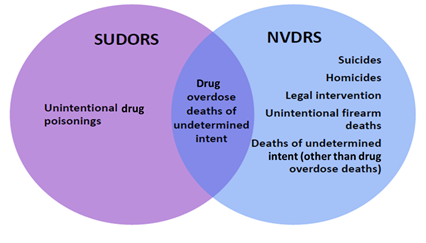California's Enhanced Surveillance Programs:
Violent Deaths and Overdose Deaths
CDPH Violence Prevention Initiative
CDPH Overdose Prevention Initiative
Data: California Opioid Overdose Surveillance Dashboard
Data: 2018 California Violent Death Reporting System Profile (PDF) - Updated 11/1/2021
Data: 2019 California Violent Death Reporting System Profile (PDF) - New!
Background
Violence and overdose are major public health problems that affect individuals, families, and entire communities. In 2018, there were:
- Nearly 6,600 violent deaths (i.e., homicides and suicides) among California residents
- More than 18 violent deaths each day
- Over 4,500 drug overdose related deaths among California residents
- More than 12 deaths each day
California's Enhanced Surveillance Programs
The California Department of Public Health was funded by the Centers for Disease Control and Prevention (CDC) to implement California's Enhanced Surveillance Programs (Cal-Enhanced). Starting in 2017, this comprehensive system combines the National Violent Death Reporting System (NVDRS) and the State Unintentional Drug Overdose Reporting System (SUDORS). It compiles information on violent and overdose deaths from various data providers (i.e., vital records, coroners/medical examiners, toxicology laboratories, and law enforcement when applicable) into one secure, confidential, and de-identified database.

NVDRS OVERVIEW
NVDRS captures data regarding violent deaths which include deaths due to:
- Homicide
- Suicide
- Unintentional firearm injury
- Legal intervention
- Undetermined deaths that are violent in nature
Information is gathered from several sources such as law enforcement reports, medical examiner reports, coroner reports, toxicology reports, and death certificates which represents the "who, when, where, and how" and provides insight to the "why." Collecting this information into one central database and analyzing this information surrounding a violent death helps recognize emerging issues and tailor prevention efforts.
CDC's NVDRS Fact Sheet (under the Overview Section)
CDC's About NVDRS
SUDORS OVERVIEW
SUDORS captures data regarding drug overdose deaths which include accidental deaths due to both illicit and prescription drugs such as:
- Opioid-related overdose
- Prescription opioids (ex. Oxycodone, Hydrocodone, Morphine, Methadone)
- Heroin
- Fentanyl
- Stimulant-related overdose
- Other drug-related overdose
As deaths from all drug-related overdoses continued to increase from 2016 to 2018, the importance of a comprehensive database grows. The information gathered from coroner/medical examiner reports and toxicology results is key to further understanding drug-related overdose deaths and can be used to inform prevention activities.
CDC's Opioid Overdose Data to Action
CDC's Opioid Overdose
Data is secure and confidential
California state statute (SB 877, Chapter 712, 2016) provides authority for the sharing of this data and protects the confidentiality of the information collected. Only limited, de-identified data are sent to CDC through this secure and confidential system.

- Victim demographic data
- Cause/manner of death
- Work-related status
- Pregnancy status
- Veteran status
| - Brief narrative of incident
- Circumstances of injury
- Toxicology reports
- Weapon information
- Wound location
- Medical history
| - Brief narrative of circumstances
- Details of weapon
- Suspect data and relationship to vicim
- Critical stessors in victim's life
- Risk factors
- Previous criminal history
- Presence of suicide notes
|
Law Enforcement, Sheriff-Coroners, Coroners, and Medical Examiners:
Your Contribution to Us
Your biggest contribution to us would be to provide us with selected information from the case reports you already complete. You would enter data directly into the secure web-based system, or provide copies of the data for CDPH to enter on your behalf.
Our Contribution to You
We will work with you to execute a data sharing agreement (DSA) and determine the best data sharing option for you, and provide you with county-level reports on our findings. Funding is available to you for this data sharing, as well as to increase your capacity for toxicology testing.
What kinds of questions will Cal-Enhanced surveillance answer?
- How many women in California were killed by intimate partner violence?
- How many overdose deaths are due to fentanyl or fentanyl-analogs in California?
- What life crises are most common in victims of suicide?
- What is the relationship between methamphetamine and heroin use?
- How often are drugs or alcohol involved in homicides and suicides?
- What are the scenarios that lead to unintentional gun deaths among children?
Both violent and overdose deaths be prevented if we work together!
Medical Examiners, Sheriff-Coroners, Coroners and Law Enforcement are at the front lines of the overdose and violence epidemics. Detailed information that is already collected (about when, where, how, and to whom these deaths occur) is key to understanding the causes of death as well as developing and evaluating prevention efforts. Cal-Enhanced presents an opportunity to combine your observations and technical work with the public health effort to strengthen California's response to the current crises devastating our communities.
Resources for Abstractors
CDC's SAMS system FAQs
NVDRS Resources, including Coding Manual
CDC's National Violent Death Reporting System (NVDRS)
For a PDF of the SUDORS Web Coding Manual, please email Cal-Enhanced@cdph.ca.gov.